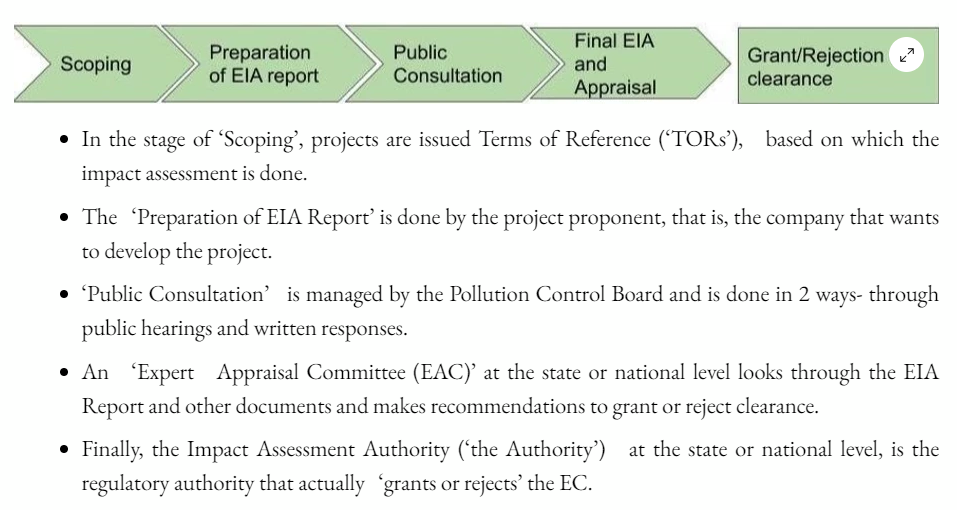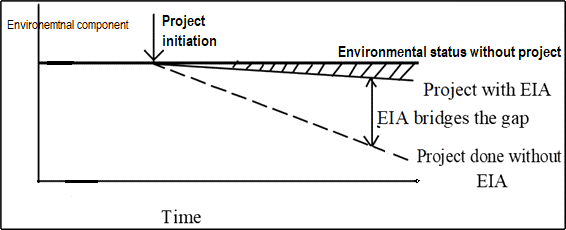Environmental Impact Assessment (EIA)
2022 JUL 28
Mains >
Environment & Ecology > National envi initiatives > Environment Impact Assessment
IN NEWS:
- The Ministry of Environment, Forests and Climate Change has notified amendment to the Environment Impact Assessment (EIA) Rules.
ENVIRONMENTAL IMPACT ASSESSMENT (EIA):
- EIA can be defined as the study to predict the effect of a proposed activity/project on the environment.
- A decision-making tool, EIA compares various alternatives for a project and seeks to identify the one which represents the best combination of economic and environmental costs and benefits.
- It aims to predict environmental impacts at an early stage in project planning and design, find ways and means to reduce adverse impacts, shape projects to suit the local environment and present the predictions and options to decision-makers.
HISTORY OF EIA IN INDIA:
- The Indian experience with EIA started in 1976-77 when the Planning Commission asked the Department of Science and Technology to examine the river-valley projects from an environmental angle.
- This was subsequently extended to cover those projects, which required the approval of the Public Investment Board.
- Till 1994, environmental clearance from the Central Government was an administrative decision and lacked legislative support.
- In January 1994, the Union Ministry of Environment and Forests (MEF), under the Environmental (Protection) Act 1986, promulgated an EIA notification making Environmental Clearance (EC) mandatory for expansion/modernisation of any activity or for setting up new projects listed in Schedule 1 of the notification.
- The present EIA Notification was issued in September, 2006.
- The notification made it mandatory for various projects such as mining, thermal power plants, infrastructure and industries to get environment clearance.
- It has categorized the projects into two: Category ‘A’ and Category ‘B’ based on their impact potential. Category ‘A’ projects will be appraised at the Central level while Category ‘B’ project at the State level.
- It puts the onus of clearing projects on the state government depending on the size/capacity of the project.

|
Recent changes:
In its latest amendment to the Rules, the ministry has made several exemptions to gaining environmental clearance:
- Highway projects of strategic and defence importance, which are 100 km from the Line of Control are exempted from an environmental clearance before construction.
- Thermal power plants up to 15 MW based on biomass or non-hazardous municipal solid waste using auxiliary fuel such as coal, lignite or petroleum products up to 15 per cent have also been exempted — as long as the fuel mix is eco-friendly.
- Increasing in the threshold of ports which exclusively deals in fish handling, and caters to small fishermen will be exempted from environmental clearance.
- Toll plazas that need more width for installation of toll collection booths, and expansion activities in existing airports related to terminal building expansion without increase in the airport’s existing area are exempted.
|
SIGNIFICANCE OF EIA:
- Sustainable development:
- By considering the environmental effects of the project and their mitigation early in the project planning cycle, EIA facilitates protection of environment and optimum resource utilisation.

- Interdisciplinary approach:
- EIA is not a science but uses many sciences in an integrated inter-disciplinary manner, evaluating phenomenon and relationships as they occur in the real world. This helps in creating a holistic assessment tool.
- Improve effectiveness of developmental works:
- EIA helps to identify the potential problems and develop alternatives, which can aid in informed decision making, saving project time and cost and lay the base for an environmentally sound project.
- Promotes people’s participation:
- Properly conducted EIA encourages peoples’ involvement in the planning of developmental works. This community participation helps to improve common man’s role in developmental works and lessen conflicts.
HISTORY OF EIA IN INDIA:
- The Indian experience with EIA started in 1976-77 when the Planning Commission asked the Department of Science and Technology to examine the river-valley projects from an environmental angle.
- This was subsequently extended to cover those projects, which required the approval of the Public Investment Board.
- Till 1994, environmental clearance from the Central Government was an administrative decision and lacked legislative support.
- In January 1994, the Union Ministry of Environment and Forests (MEF), under the Environmental (Protection) Act 1986, promulgated an EIA notification making Environmental Clearance (EC) mandatory for expansion/modernisation of any activity or for setting up new projects listed in Schedule 1 of the notification.
- The present EIA Notification was issued in September, 2006.
- The notification made it mandatory for various projects such as mining, thermal power plants, infrastructure and industries to get environment clearance.
- It has categorized the projects into two: Category ‘A’ and Category ‘B’ based on their impact potential. Category ‘A’ projects will be appraised at the Central level while Category ‘B’ project at the State level.
- It puts the onus of clearing projects on the state government depending on the size/capacity of the project.
ISSUES SURROUNDING EIA IN INDIA:
- Lack of effective regulation:
- The existing EIA framework is plagued by the lack of efficient monitoring and verification process. There are no standardized systems for appointment of consultants, scrutiny of reports or punishment for violation of the ToR.
- Responsibility of the project proponent:
- In India, it is the project proponent that conducts the EIA study. This leads to issues like poor quality EIA reports, where actual facts are hidden and the plagiarized EIA reports.
- Plagiarism:
- Several industries are making a mockery of the EIA by resorting to mere “cut and paste” jobs in their reports.
- Eg: A case of alleged plagiarism was Ashapura Minechem, a bauxite mining project in Ratnagiri in Maharashtra, wherein the report was said to be plagiarised from a project in Russia.
- Efforts to dilute EIA:
- Issues with TOR:
- During ‘Scoping’, projects are issued Terms of Reference (‘TORs’), based on which the impact assessment is done. However, in many cases, standard TORs are issues based on the sector, without taking into account the peculiarities of the landscape. Hence, TORs for a power project in a hilly area and plains would be similar.
- Issues with public consultation:
- ‘Public consultation’ is very limited because, by the time this process starts, the EIA study is complete and the draft report is already prepared.
- Also, there are several exceptions and dilutions within the public consultation process.
- Isolation from other Environmental Laws:
- The Forest Rights Act, 2006, the Biological Diversity Act, 2002, the PESA Act, 1996 and Panchayati Raj Acts of states give rights to local governments to manage environmental resources. However, there has been little effort to integrate the EIA framework with this framework of environmental governance.
- Non-availability of Environmental Clearance in public domain:
- Regulation 10(i)(a) of the 2006 EIA notification requires the project proponent to publish the Environmental Clearance in 2 newspapers of the District or State where the project is located stating the conditions and safeguards in the same. In most cases, this is not followed.
- Exemption for controversial projects:
|
CASE STUDY: Mega development project in the Great Nicobar Island
- The NITI Aayog has come up with a Rs. 72,000-crore plan for the “Holistic Development of the Great Nicobar Island”.
- This integrated project in Great Nicobar includes construction of a mega port, an airport complex, a township spread over 130 sq. km of pristine forest and a solar and gas-based power plant.
- Andaman and Nicobar Islands Integrated Development Corporation Ltd. (ANIIDCO) is the project proponent and Hyderabad-based Vimta Labs Ltd. hired for conducting the EIA.
- The EIA of the project is criticised on the following grounds:
- Violation of TOR: While the ToR for preparing the EIA was finalised only in May 2021, the report itself lists many instances of field studies conducted by the consultant as early as December 2020.
- Incomplete and incorrect data: There are serious issues of scientific accuracy and integrity of data presented.
- The area of the island is mentioned in one place as 1,045 sq. km, while it is 910 sq. km (the current official figure) in another.
- The report mentions that the Galathea port area does not record any coral reefs, whereas the ZSI study appended to the EIA reports a coral reef spread over 116 hectares in Galathea Bay.
- The report says that 330 species of fauna are recorded in the island, while the ZSI study puts the number at 695.
- The EIA says no migratory birds have been reported from Great Nicobar, whereas it is well known that these islands are located along two globally significant bird flyways and > 40 species of migratory birds have been recorded.
|
WAY FORWARD:
- Focus on conservation:
- EIA should not be treated as an appendage to a project, but be regarded as an integral part of project planning. The focus of EIA needs to shift from utilization and exploitation of natural resources to conservation of natural resources.
- Incorporate panchayats:
- The EIA process must, drawing from different laws, recognize the critical role of Panchayats in the development of the area by ensuring full participation and consent of the Panchayat from the ‘Scoping’ stage itself.
- Broader consultation:
- Rather than a simple ‘consultation’ process, the full consent and participation of the Gram Sabha must be secured within the EIA framework.
- Empower people:
- The government, instead of reducing the time for public consultation, should focus on ensuring access to information as well as awareness about the public hearing and its impact upon the whole EIA process.
- A centralized data bank:
- A centralized data bank needs to be created for the dissemination of all information related to projects from notification to clearance to local communities and general public.
- Social Impact Assessment (SIA):
- With the EIA, India also need SIA to achieve sustainable development in true sense.
PRACTICE QUESTION:
Q. The present system of Environmental Impact Assessment (EIA) needs to be revamped to restore confidence in the process. Discuss?

